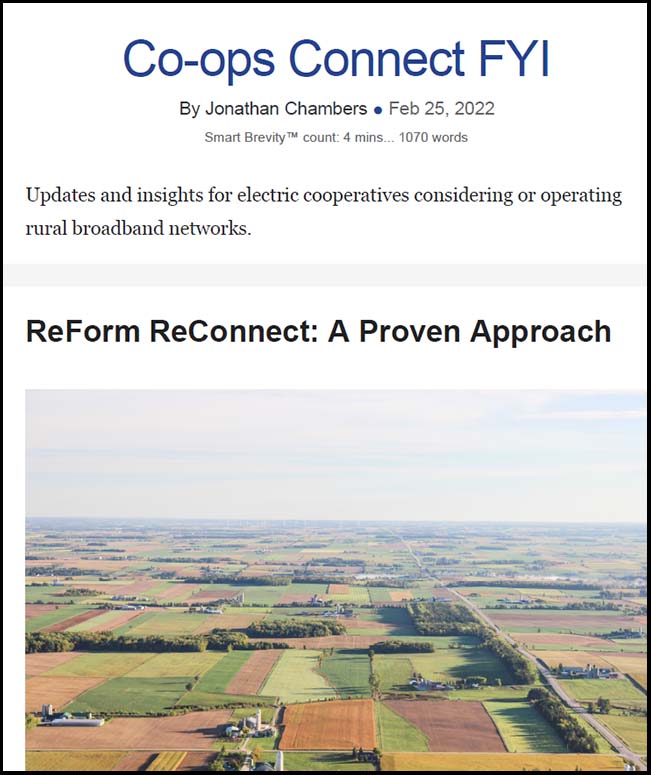ReForm ReConnect: A Proven Approach
February 25, 2022
- The digital divide was created and perpetuated by programs meant to resolve it because of these programs’ funding limitations, building restrictions, and out-of-date standards.
- Updates and insights for electric cooperatives considering or operating rural broadband networks.
- Contrary to incumbent provider claims, bringing high-speed internet access to rural areas isn’t overbuilding, it’s building.
This week, a different model for success:
The Rural Electrification Administration helped deliver one of the nation’s great infrastructure success stories.
It is no wonder that policymakers of every stripe have pointed to the history of rural electrification as a model for rural broadband.
Is it the right model?
RUS and Rural Broadband
A quick look back:
In 1994, the REA became a part of the USDA’s Rural Utilities Service, which also oversees rural telephone and water programs.RUS has a more limited mandate for broadband than it had for rural electrification because most broadband funding (including to RUS telecom borrowers) has been managed by the FCC.
- RUS oversees three broadband-related programs:
1. Traditional loan program to telephone company borrowers
2. Smart Grid fiber-to-the-meter program
3. ReConnect program
Go deeper:
Telecommunications loans
- All telecom borrowers at RUS also receive subsidies from the FCC.
Smart grid loans
- In the early 2010s, RUS began a highly successful smart grid program to loan funds to electric co-ops to build fiber to connect substations and follow distribution lines all the way to the meter.
- This is an essential program for the future management of the electric grid.
- The excess capacity of the fiber can be used by electric co-ops to deliver broadband to their members.
- In 2021, the RUS Electric Division loaned more for fiber smart grid construction than it did for electric distribution lines.
- ReConnect grants and loans ReConnect is administered by the RUS telecom division and was conceived as a pilot broadband program.
ReConnect has continued to receive appropriations by Congress, including $2 billion in the Infrastructure Act.
Case Study: Central Virginia Electric Cooperative and Firefly
Case in action:
- Central Virginia Electric Cooperative (CVEC) is by many measures the most successful electric cooperative smart grid/broadband operation in the country.
- CVEC is building a smart grid fiber network with RUS loans.Its subsidiary, Firefly, is operating a fiber broadband network to bring service to CVEC members. Firefly has also partnered with neighboring electric co-ops, communities and an IOU, Dominion Energy, to bring broadband to a large swath of central Virginia.
Why it matters: CVEC participated in the first round of ReConnect.
Firefly participated in the second round. Each “won” funds. Then came the bureaucracy.
Despite:
1. Having been an REA/RUS borrower for over 80 years;
2. Being a current smart grid borrower from RUS;
3. Operating a successful broadband business in a separate subsidiary, in full compliance with RUS and Virginia regulations;
4. Planning to use ReConnect in the same geographic areas, even feeders off the same substations, as the RUS smart grid loan area
It took RUS over 18 months to approve the paperwork in Round 1.
Is it better for Round 2?
- No, still pending. Over 18 months and counting.
The Issue with ReConnect
Electric co-op fiber builds, particularly those using fiber for smart grid, are different than telecommunications fiber builds.
Key differentiator: “We follow power” describes how our networks are designed, architected, and constructed, and how they differ from telecom builds.
Specifically:
1. Engineering practices
Unlike telecom and cable companies, electric co-ops collect and maintain GIS data on their electric system and can use software for their fiber design, which is faster and more accurate.
The bottom line: Requiring electric co-ops to use telecom engineering, as in the ReConnect program, is a misunderstanding of electric co-op fiber networks.
2. Make-ready work
RUS Electric Division borrowers often perform make-ready work when building out broadband. This means they may have to move a wire or transformer box on a pole to make room for fiber.Typically, the associated cost of this make-ready work is determined by the RUS Electric Program. ReConnect, however, considers it a new and different contract.
The bottom line: Make-ready costs are higher under ReConnect.
3. Subcontractors
Under ReConnect regulation, a recipient may not use subcontractors for more than 50% of the project work.
The bottom line: This regulation does not reflect the realities of the electric co-op industry and delays broadband access.
4. Environmental review timelines
Electric co-ops build fiber on existing infrastructure, which should be categorically exempt from most environmental review.
Co-ops have found that the review process for ReConnect is different than the review process for the same activity building smart grid.
The bottom line: Smart Grid program timelines for environmental review are more efficient.
5. Sense of urgency
RUS Electric Division borrowers typically receive a reimbursement within one day but understand that a comprehensive audit will take place. (All work must undergo a federal audit.)
This differs in the ReConnect program, where an internal deadline of 30 days is typical for decision-making. The 30-day review period does not start until the question and answer process is complete.
Under ReConnect, internal staff decisions determined that reimbursements won’t be provided prior to 60 days.
The bottom line: The internal timeline decisions cause undue and costly delays.
There are other differences related to depreciation, parent/subsidiary financials, as well as contradictory telecom/electric forms and regulations.
Final Thought
Big picture:
RUS is trying to view electric co-ops through the prism of telecommunications companies.
The first ReConnect award, announced at a ceremony with the Secretary of Agriculture, never received funding because of RUS’s conflicting regulations.
As one co-op put it:
“I have many more examples of silliness and waste due to the RUS Telecom ‘it’s in the regs’ approach to building a system instead of allowing the use of common sense and best practices.”
This is a frustrating departure for the cooperatives that have been the cornerstone of the REA/RUS for over 85 years.
This paradigm results in lost time and money.
How do we fix it?
Maintain the current application — with one key change.
When winning applicants are identified, allow those who have an electric use for fiber to opt into administration of their grant and/or loan under the Smart Grid program.
The Smart Grid program yields greater efficiency and results than the ReConnect program does.

